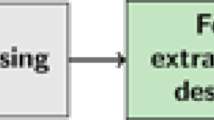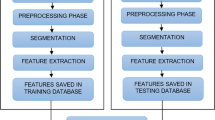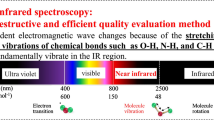Abstract
Classification of wood species using computer-related technology is not only significant in the modernization of wood industrialization, but also makes it easier for nonwood professionals to identify different wood types accurately and avoid being deceived. Presently, most wood classification methods use a single feature to describe the wood, which is restrictive and provides incomplete information. In this study, macroscopic transverse section images and spectral curves of wood were used as the research objects, and 50 species of wood were classified. A wood species identification method based on the fusion of spectral features and texture features is proposed, which has the advantages of convenient data collection, fast identification speed, high identification accuracy, and anti-noise interference. First, a digital camera and a spectrometer were used to acquire the image and spectral curve from the wood transverse sections. The acquired spectral and texture features of the wood transverse sections were extracted with the fractal method and the local binary pattern theory method, respectively, and both extracted features were fused using the canonical correlation analysis feature fusion method. The fused features were then classified using a support vector machine classifier. The experimental results demonstrated that the classification accuracy of the texture and spectral features alone was 91.96% and 92.67%, respectively, whereas that of the fused features was 99.16% in the “leave-one-out” cross-validation. The wood classification method outlined in this paper has higher classification accuracy than existing mainstream methods. In addition, even after adding noise to the image and spectrum, it was observed that the classification accuracy did not decrease significantly, which indicates that the method described in this paper achieves excellent classification even in the presence of noise interference.










Similar content being viewed by others
References
Ahonen T, Hadid A, Matti Pietikäinen (2004) Face recognition with local binary patterns. In: European conference on computer vision. Springer, Berlin, pp 469–481.
Armi L, Fekri-Ershad S (2019) Texture image analysis and texture classification methods—a review. arXiv:1904.06554
Barmpoutis P, Dimitropoulos K, Barboutis I, Grammalidis N, Lefakis P (2018) Wood species recognition through multidimensional texture analysis. Comput Electron Agric 144:241–248
Beale MH, Hagan MT, Demuth HB, Howard BD (2020) Deep Learning Toolbox™ User’s Guide (V14.1). The MathWorks, Inc, vol 1, pp 12–18. https://ww2.mathworks.cn/help/deeplearning/ug/pretrained-convolutional-neural-networks.html?lang=en. Accessed July 2020 to Dec 2020
Browne MW (2000) Cross-validation methods. J Math Psychol 44(1):108–132
Chen J, Chen Z, Chi Z, Fu H (2016) Facial expression recognition in video with multiple feature fusion. IEEE Trans Affect Comput 9(1):38–50
Da Silva NR, De Ridder M, Baetens JM, Van den Bulcke J, Rousseau M, Bruno OM, De Baets B (2017) Automated classification of wood transverse cross-section micro-imagery from 77 commercial Central-African timber species. Ann for Sci 74:30. https://doi.org/10.1007/s13595-017-0619-0
De Geus AR, Backes AR, Gontijo AB, Giovanna HQA, Jefferson RS (2021) Amazon wood species classification: a comparison between deep learning and pre-designed features. Wood Sci Technol 55:857–872. https://doi.org/10.1007/s00226-021-01282-w
Gneiting T, Ševčíková H, Percival DB (2012) Estimators of fractal dimension: assessing the roughness of time series and spatial data. Stat Sci 27(2):247–277
Haghighat M, Abdel-Mottaleb M, Alhalabi W (2016) Fully automatic face normalization and single sample face recognition in unconstrained environments. Expert Syst Appl 47(1):23–34
He K, Zhang X, Ren S, Sun Y (2016) Deep residual learning for image recognition. In Proceedings of the IEEE conference on computer vision and pattern recognition, Las Vegas, America, pp 770–778
Hu J, Song W, Zhang W, Zhao YF, Alper Y (2019) Deep learning for use in lumber classification tasks. Wood Sci Technol 53:505–517
Iandola FN, Han S, Moskewicz MW, Ashraf K, Dally WJ, Keutzer K (2016) SqueezeNet: AlexNet-level accuracy with 50x fewer parameters and < 0.5 MB model size. arXiv:1602.07360
Ibrahim I, Khairuddin ASM, Talip MSA, Arof H, Yusof R (2017) Tree species recognition system based on macroscopic image analysis. Wood Sci Technol 51(2):431–444
Ibrahim I, Khairuddin ASM, Arof H, Yusof R, Hanafi E (2018) Statistical feature extraction method for wood species recognition system. Eur J Wood Prod 76(1):345–356
Jiao L, Lu Y, He T, Li J, Yin Y (2019) A strategy for developing high-resolution DNA barcodes for species discrimination of wood specimens using the complete chloroplast genome of three Pterocarpus species. Planta 250(1):95–104
Li Z, Liu C (2009) Gray level difference-based transition region extraction and thresholding. Comput Electr Eng 35(5):696–704
Liu L, Ji M, Dong Y, Zhang R, Buchroithner M (2016) Quantitative retrieval of organic soil properties from visible near-infrared shortwave infrared (Vis-NIR-SWIR) spectroscopy using fractal-based feature extraction. Remote Sens 8(12):1035
Mukherjee K, Ghosh JK, Mittal RC (2013) Variogram fractal dimension based features for hyperspectral data dimensionality reduction. J Indian Soc Remote Sens 41(2):249–258
Peng Z, Yue L (2019) Simultaneous prediction of wood density and wood species based on visible/near infrared spectroscopy. Spectrosc Spectr Anal 39(11):3525–3532 ((in Chinese))
Pozhidaev VM, Retivov VM, Panarina EI, Sergeeva YE, Zhdanovich OA, Yatsishina EB (2019) Development of a method for identifying wood species in archaeological materials by IR spectroscopy. J Anal Chem 74(12):1192–1201
Rojas JAM, Alpuente J, Postigo D, Rojas IM, Vignote S (2011) Wood species identification using stress-wave analysis in the audible range. Appl Acoust 72(12):934–942
Rosli NR, Khairuddin U, Yusof R, Ghapar HA, Khairuddin ASM, Ahmad NA (2019) Online system for automatic tropical wood recognition. Elektrika J Electr Eng 18(3–2):1–6
Simonyan K, Zisserman A (2014) Very deep convolutional networks for large-scale image recognition. arXiv:1409.1556
Sun QS, Zeng SG, Liu Y, Heng PA, Xia DS (2005) A new method of feature fusion and its application in image recognition. Pattern Recogn 38(12):2437–2448
Szegedy C, Liu W, Jia Y, Sermanet P, Reed S, Anguelov D, Rabinovich A (2015) Going deeper with convolutions. In: Proceedings of the IEEE conference on computer vision and pattern recognition, Boston, America, pp 1–9
Wu CM, Chen YC, Hsieh KS (1992) Texture features for classification of ultrasonic liver images. IEEE Trans Med Imaging 11(2):141–152
Yu M, Jiao L, Guo J, Wiedenhoeft AC, He T, Jiang X, Yin Y (2017) DNA barcoding of vouchered xylarium wood specimens of nine endangered Dalbergia species. Planta 246(6):1165–1176
Yusof R, Khalid M, Khairuddin ASM (2013) Application of kernel-genetic algorithm as nonlinear feature selection in tropical wood species recognition system. Comput Electron Agric 93:68–77
Zamri MIAPB, Cordova F, Khairuddin ASM, Mokhtar N, Yusof R (2016) Tree species classification based on image analysis using Improved-Basic Gray Level Aura Matrix. Comput Electron Agric 124:227–233
Zhang M, Wang N, Li Y, Gao X (2019) Neural probabilistic graphical model for face sketch synthesis. IEEE Trans Neural Netw Learn Syst 31(7):2623–2637
Zhao P (2013) Robust wood species recognition using variable color information. Optik Int J Light Electron Opt 124(17):2833–2836
Acknowledgements
This research was supported by the National Natural Science Foundation of China (Grant no. 31670717) and the Fundamental Research Funds for the Central University (Grant no. 2572017EB09).
Author information
Authors and Affiliations
Corresponding author
Additional information
Publisher's Note
Springer Nature remains neutral with regard to jurisdictional claims in published maps and institutional affiliations.
Supplementary Information
Below is the link to the electronic supplementary material.
Rights and permissions
About this article
Cite this article
Wang, CK., Zhao, P. Classification of wood species using spectral and texture features of transverse section. Eur. J. Wood Prod. 79, 1283–1296 (2021). https://doi.org/10.1007/s00107-021-01728-9
Received:
Accepted:
Published:
Issue Date:
DOI: https://doi.org/10.1007/s00107-021-01728-9




